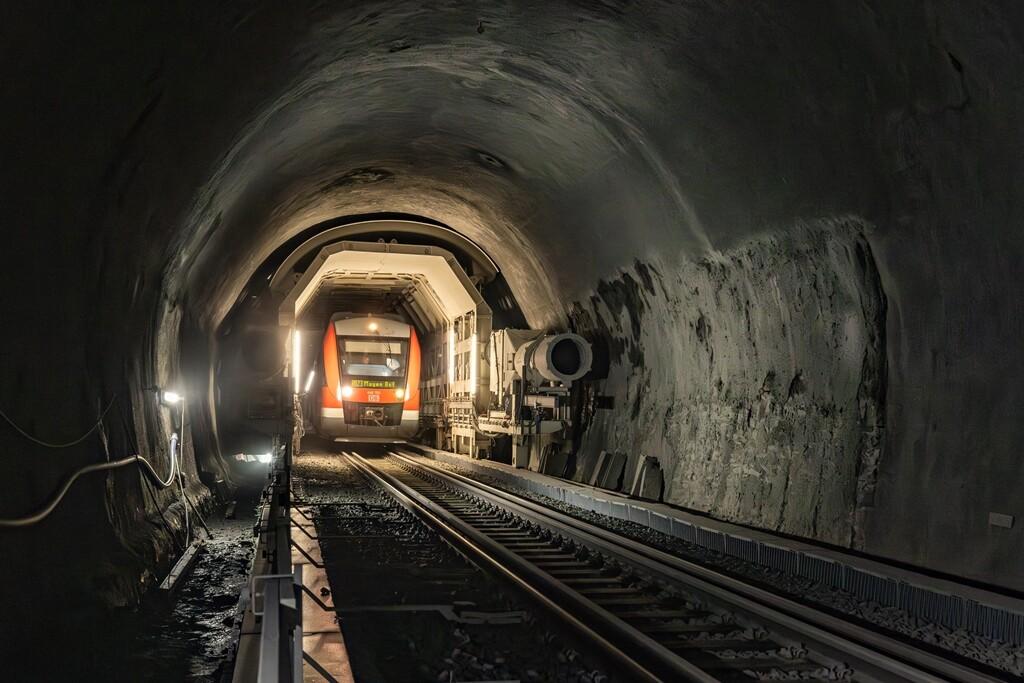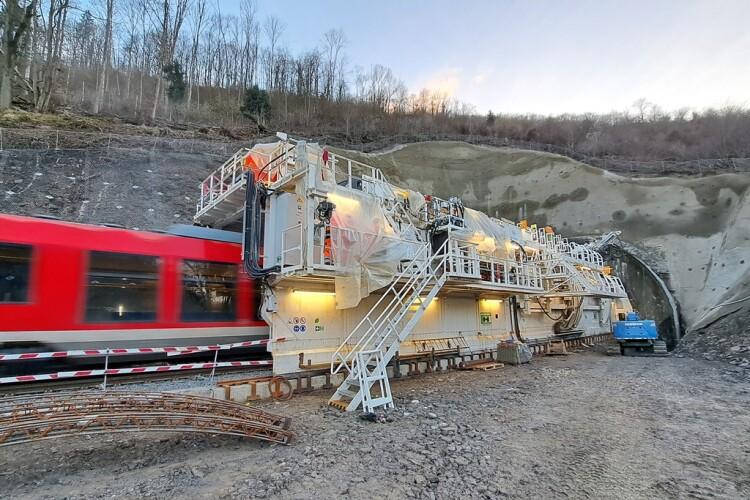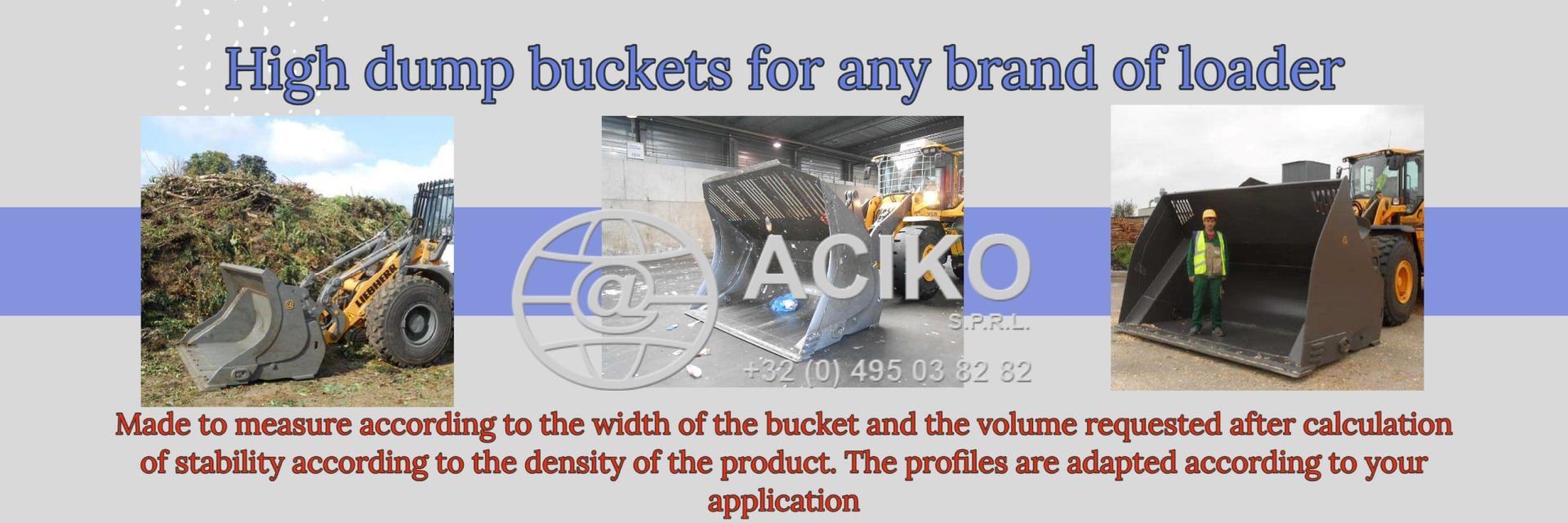R.E.News International-Tunnels can be widened without stopping the trains
 03/10/24-FR-English-NL-footer
03/10/24-FR-English-NL-footer
Les tunnels peuvent être élargis sans arrêter les trains

 Image- Herrenknecht
Image- Herrenknecht
Les chemins de fer allemands utilisent un nouveau système qui permet d'élargir les tunnels tout en laissant les trains circuler.
Herrenknecht, plus connu pour ses tunneliers, a développé un système d'élargissement de tunnel (TES) pour permettre l'électrification des lignes ferroviaires.
Dans la seconde moitié du XIXe siècle et au début du XXe siècle, des centaines de tunnels ferroviaires ont été construits en Europe. Ils sont en grande partie encore en service aujourd'hui. Dans les décennies à venir, un grand nombre d'entre eux devront être rénovés. Le système d'élargissement de tunnel Herrenknecht (TES) offre une solution pour élargir le profil des anciens tunnels ferroviaires tout en maintenant le trafic ferroviaire.
Deux machines TES de Herrenknecht sont utilisées depuis janvier 2024 pour le renouvellement des tunnels de la Deutsche Bahn (chemins de fer allemands) vieux de 160 ans près de Limburg an der Lahn. Les tunnels sont en cours de rénovation tandis que le service ferroviaire continue. Le tunnel de Fachingen, long de 426 mètres, et le tunnel de Cramberg, long de 732 mètres, font partie du chemin de fer de la vallée de la Lahn, qui relie les villes de Coblence et de Wetzlar.
Le TES consiste tout d'abord à démonter les voies existantes et à poser une voie au milieu du tube existant. Le trafic ferroviaire continue de circuler sur cette voie pendant toute la durée des travaux. Le TES avance pas à pas lors des travaux d'excavation pour l'élargissement du tunnel. En même temps, il sert d'enceinte de protection et sépare les travaux de construction du trafic ferroviaire actif.
Pour les deux tunnels à double voie du chemin de fer de la vallée de la Lahn, le rayon de la section transversale du tunnel est agrandi de deux mètres, ce qui permet d'obtenir des dimensions correspondant aux nouveaux tunnels actuels.
Informations connexes
Les TES des tunnels de Fachingen et de Cramberg mesurent 46 mètres de long, pèsent 270 tonnes et ont un diamètre d'environ 12 mètres. Ils roulent sur des fondations et des rails spécialement posés dans le tunnel. Les machines sont équipées pour les travaux d'excavation et de soutènement conventionnels. Selon la dureté de la roche, l'excavation se fait par burinage ou dynamitage. Tout d'abord, les anciens murs du tunnel, généralement en maçonnerie, sont cassés. Ensuite, la roche est creusée par burinage ou dynamitage et le matériau est enlevé. Le matériau excavé tombe sur le côté de la machine dans le radier du tunnel et est évacué par un convoyeur et un équipement de chargement séparés. Après chaque tour de forage et de dynamitage, un manipulateur de béton projeté applique un soutènement temporaire en béton projeté. La roche est également stabilisée à l'aide d'ancrages. Des treillis d'armature et des arches en acier ainsi que le béton projeté et les ancrages forment le soutènement initial. Une fois le creusement du tunnel avec le TES terminé, le revêtement final du tunnel en béton coulé sur place est ensuite réalisé dans une deuxième phase de construction.
Le TES est composé de trois parties. La partie avant de la machine sert à la protection avant le creusement. Elle empêche l'effondrement du tunnel existant dans la zone précédant les travaux d'excavation respectifs ou la chute de pierres sur les voies. La partie centrale est le support des équipements nécessaires au creusement du tunnel : foreuses télescopiques des deux côtés, marteau à percussion hydraulique sur une flèche centrale à grand rayon d'action, système de béton projeté sur un guide annulaire. La machine dispose de grandes plateformes de travail rétractables qui permettent aux travailleurs d'atteindre le front de taille du tunnel et l'intrados. L'équipement pour le fonctionnement du TES est situé dans la partie arrière de la machine. Il comprend une station hydraulique pour alimenter les équipements à entraînement hydraulique, un compresseur pour l'alimentation en air comprimé, le système électrique et un stockage de matériaux.
La conception du TES utilisé sur le chemin de fer de la vallée de la Lahn s'est inspirée de l'expérience du TES Herrenknecht utilisé pour la première fois en Espagne pour la rénovation du tunnel de Gaintxurizketa de 558 mètres de long entre Astigarraga et Irun dans les contreforts des Pyrénées basques. Cela a été achevé en mars 2024.
NJC.© Info Herrenknecht
----------------------------------------------------------------------------------------------------------------
 03/10/24-English
03/10/24-English
Tunnels can be widened without stopping the trains

 Image- Herrenknecht
Image- Herrenknecht
German railways are using a new system that allows tunnels to be widened while keeping the trains running through.
Herrenknecht, better know for its tunnel boring machines has developed a tunnel widening system (TES) to enable railway lines to be electrified.
In the second half of the 19th and early 20th centuries, hundreds of railway tunnels were built in Europe. They are largely still in operation today. In the coming decades, a many are due for renewal. The Herrenknecht Tunnel Enlargement System (TES) offers a solution for widening the profile of old railway tunnels while rail traffic continues to run.
Two TES machines from Herrenknecht have been in use since January 2024 for the renewal of 160-year-old Deutsche Bahn (German Railways) tunnels near Limburg an der Lahn. The tunnels are being renovated while rail service continues. The 426-metre long Fachingen tunnel and the 732-meter long Cramberg tunnel are part of the Lahn Valley Railway connecting the cities of Koblenz and Wetzlar.
With the TES, first the existing tracks are dismantled and a track is laid in the middle of the existing tube instead. Rail traffic continues to run on this track throughout the entire construction period. The TES moves forward step by step during excavation for the widening of the tunnel. At the same time, it serves as a protective enclosure and separates the construction work from live rail traffic.
For the two double-track tunnels of the Lahn Valley Railway, the radius of the tunnel cross section is being enlarged by a two metres, thus achieving dimensions corresponding to current new tunnels.
Related Information
The TES on the Fachingen and Cramberg tunnels are 46-metre long, 270-tonnes and have a diameter of around 12 metres. They run on foundations and rails specially laid in the tunnel. The machines are equipped for conventional excavation and support work. Depending on the hardness of the rock, excavation is done by chiselling or blasting. First, the old tunnel walls, usually masonry, are broken out. This is followed by excavation of the rock by chiselling or blasting and removal of the material. The excavated material falls to the side of the machine into the tunnel invert and is removed by separate conveyor and loading equipment. After each drilling and blasting round, a shotcrete manipulator applies temporary shotcrete support. The rock is also stabilised with anchors. Reinforcement mesh and steel arches together with the shotcrete and anchors form the initial support. Once tunnelling with the TES has been completed, the final lining of the tunnel using in-situ concrete is then carried out in a second construction phase.
The TES consists of three parts. The front part of the machine is used for pre-excavation protection. It prevents the existing tunnel from collapsing in the area ahead of the respective excavation work or rock falling onto the tracks. The middle section is the carrier for the equipment required for tunnelling: telescopic drill rigs on both sides, hydraulic impact hammer on a central boom with a large radius of action, shotcrete system on a ring guide. The machine has large, retractable working platforms that allow workers to reach the tunnel face and the intrados. The equipment for operating the TES is located in the rear part of the machine. This includes a hydraulic station to supply the hydraulically driven equipment, a compressor for the supply of compressed air, the electrical system, and a material storage.
The design of the TES used on the Lahn Valley Railway incorporated experience from Herrenknecht TES first used in Spain to renovate the 558-metre long Gaintxurizketa tunnel between Astigarraga and Irun in the foothills of the Basque Pyrenees. This was completed in March 2024.
NJC.© Info Herrenknecht
-----------------------------------------------------------------------------------------------------------------
 03/10/24-NL
03/10/24-NL
Tunnels kunnen worden verbreed zonder dat de treinen stoppen

 Image- Herrenknecht
Image- Herrenknecht
De Duitse spoorwegen gebruiken een nieuw systeem waarmee tunnels kunnen worden verbreed terwijl de treinen blijven rijden.
Herrenknecht, beter bekend om zijn tunnelboormachines, heeft een tunnelverbredingssysteem (TES) ontwikkeld om spoorlijnen te kunnen elektrificeren.
In de tweede helft van de 19e en begin 20e eeuw werden in Europa honderden spoortunnels gebouwd. Ze zijn grotendeels nog steeds in bedrijf. In de komende decennia zijn er veel aan vernieuwing toe. Het Herrenknecht Tunnel Enlargement System (TES) biedt een oplossing om het profiel van oude spoortunnels te verbreden terwijl het treinverkeer doorgaat.
Sinds januari 2024 zijn twee TES-machines van Herrenknecht in gebruik voor de vernieuwing van 160 jaar oude Deutsche Bahn (Duitse Spoorwegen) tunnels bij Limburg an der Lahn. De tunnels worden gerenoveerd terwijl het treinverkeer doorgaat. De 426 meter lange Fachingentunnel en de 732 meter lange Crambergtunnel maken deel uit van de Lahntalbahn die de steden Koblenz en Wetzlar met elkaar verbindt.
Met de TES worden eerst de bestaande sporen gedemonteerd en in plaats daarvan wordt in het midden van de bestaande buis een spoor aangelegd. Het treinverkeer blijft gedurende de gehele bouwperiode over dit spoor rijden. De TES beweegt stapsgewijs vooruit tijdens de graafwerkzaamheden voor de verbreding van de tunnel. Tegelijkertijd dient het als beschermende omheining en scheidt het de bouwwerkzaamheden van het actieve treinverkeer.
Voor de twee dubbelsporige tunnels van de Lahntalbahn wordt de straal van de tunneldoorsnede met twee meter vergroot, waardoor afmetingen worden bereikt die overeenkomen met de huidige nieuwe tunnels.
Gerelateerde informatie
De TES op de Fachingen- en Crambergtunnels zijn 46 meter lang, 270 ton zwaar en hebben een diameter van ongeveer 12 meter. Ze rijden op funderingen en rails die speciaal in de tunnel zijn gelegd. De machines zijn uitgerust voor conventionele graaf- en ondersteuningswerkzaamheden. Afhankelijk van de hardheid van het gesteente wordt er gegraven door beitelen of stralen. Eerst worden de oude tunnelwanden, meestal metselwerk, uitgebroken. Daarna wordt het gesteente uitgegraven door beitelen of stralen en wordt het materiaal verwijderd. Het uitgegraven materiaal valt aan de zijkant van de machine in de tunnelomkeer en wordt verwijderd door een aparte transportband en laadapparatuur. Na elke boor- en straalronde brengt een spuitbetonmanipulator tijdelijke spuitbetonondersteuning aan. Het gesteente wordt ook gestabiliseerd met ankers. Wapeningsnet en stalen bogen vormen samen met het spuitbeton en de ankers de eerste ondersteuning. Nadat het tunnelen met de TES is voltooid, wordt de definitieve bekleding van de tunnel met in-situ beton uitgevoerd in een tweede bouwfase.
De TES bestaat uit drie delen. Het voorste deel van de machine wordt gebruikt voor bescherming vóór de graafwerkzaamheden. Het voorkomt dat de bestaande tunnel instort in het gebied vóór de betreffende graafwerkzaamheden of dat er gesteente op de sporen valt. Het middelste deel is de drager voor de apparatuur die nodig is voor het tunnelen: telescopische boorinstallaties aan beide zijden, hydraulische slaghamer op een centrale giek met een grote actieradius, spuitbetonsysteem op een ringgeleider. De machine heeft grote, intrekbare werkplatforms waarmee werknemers de tunnelwand en de intrados kunnen bereiken. De apparatuur voor het bedienen van de TES bevindt zich in het achterste deel van de machine. Dit omvat een hydraulisch station om de hydraulisch aangedreven apparatuur te voeden, een compressor voor de levering van perslucht, het elektrische systeem en een materiaalopslag.
Het ontwerp van de TES die wordt gebruikt op de Lahn Valley Railway is gebaseerd op de ervaring van Herrenknecht TES die voor het eerst in Spanje werd gebruikt om de 558 meter lange Gaintxurizketa-tunnel tussen Astigarraga en Irun in de uitlopers van de Baskische Pyreneeën te renoveren. Dit werd in maart 2024 afgerond.
NJC.© Info Herrenknecht
-------------------------------------------------------------------------------------------------------------------
Date de dernière mise à jour : 02/10/2024

















